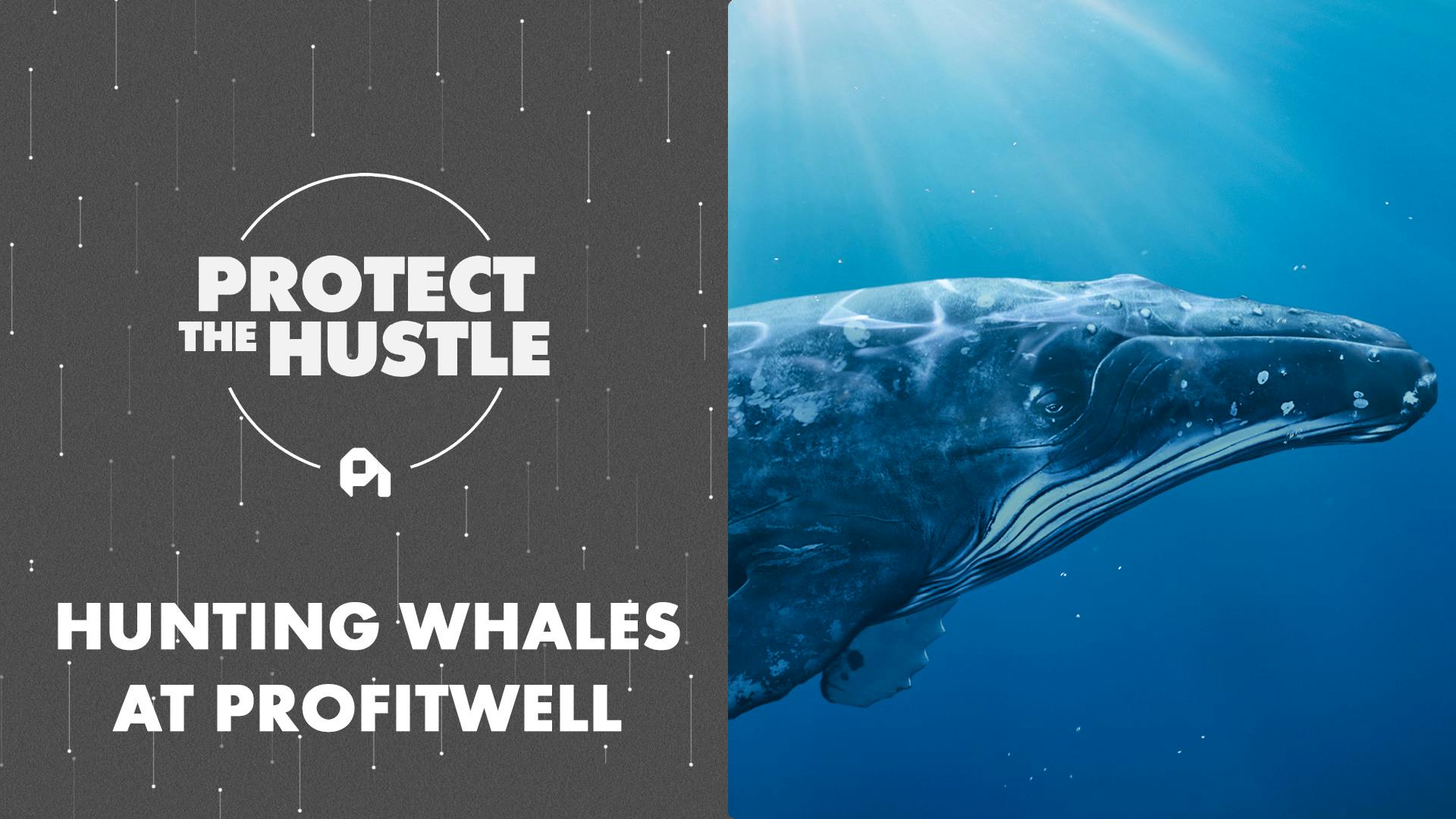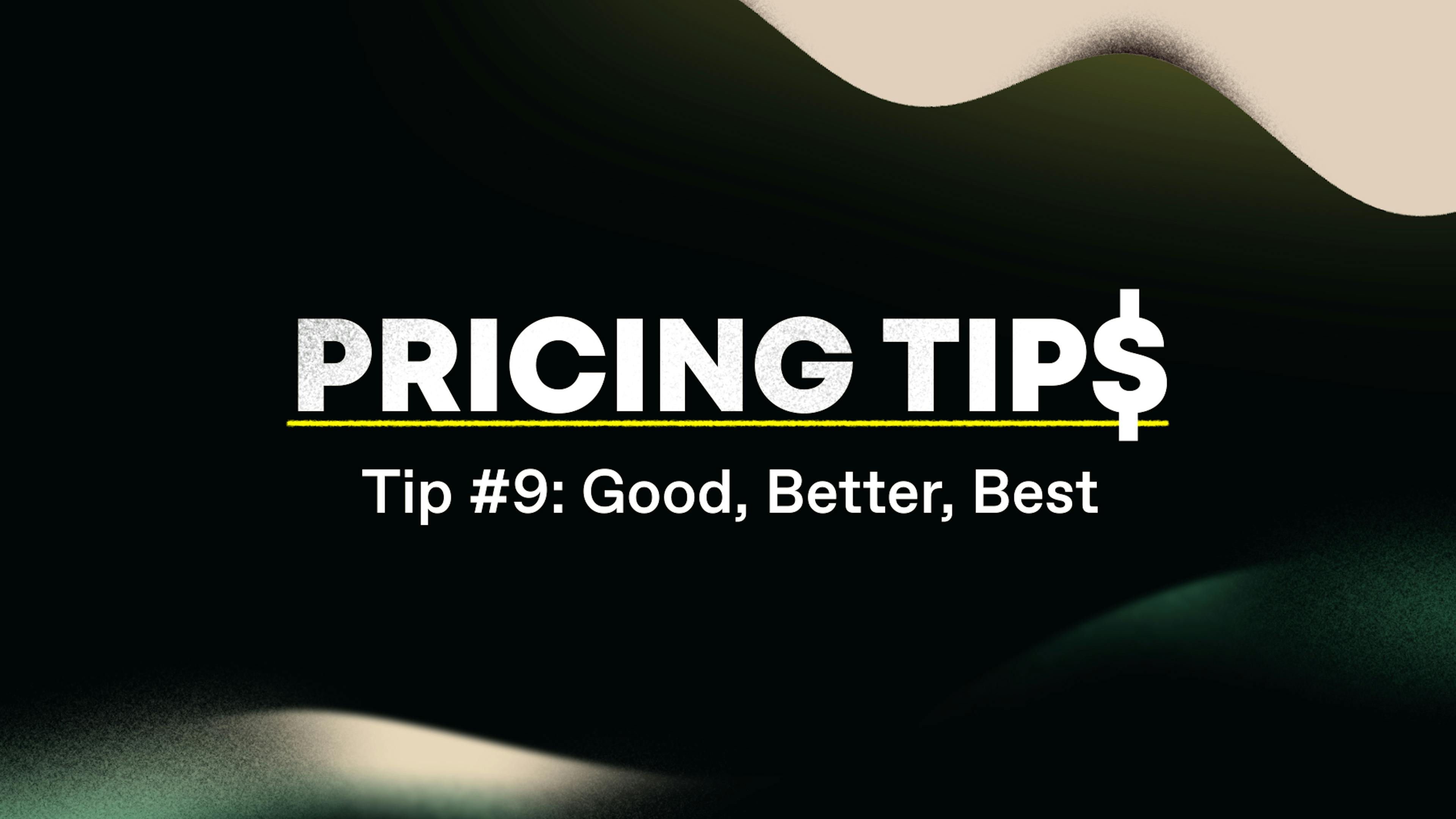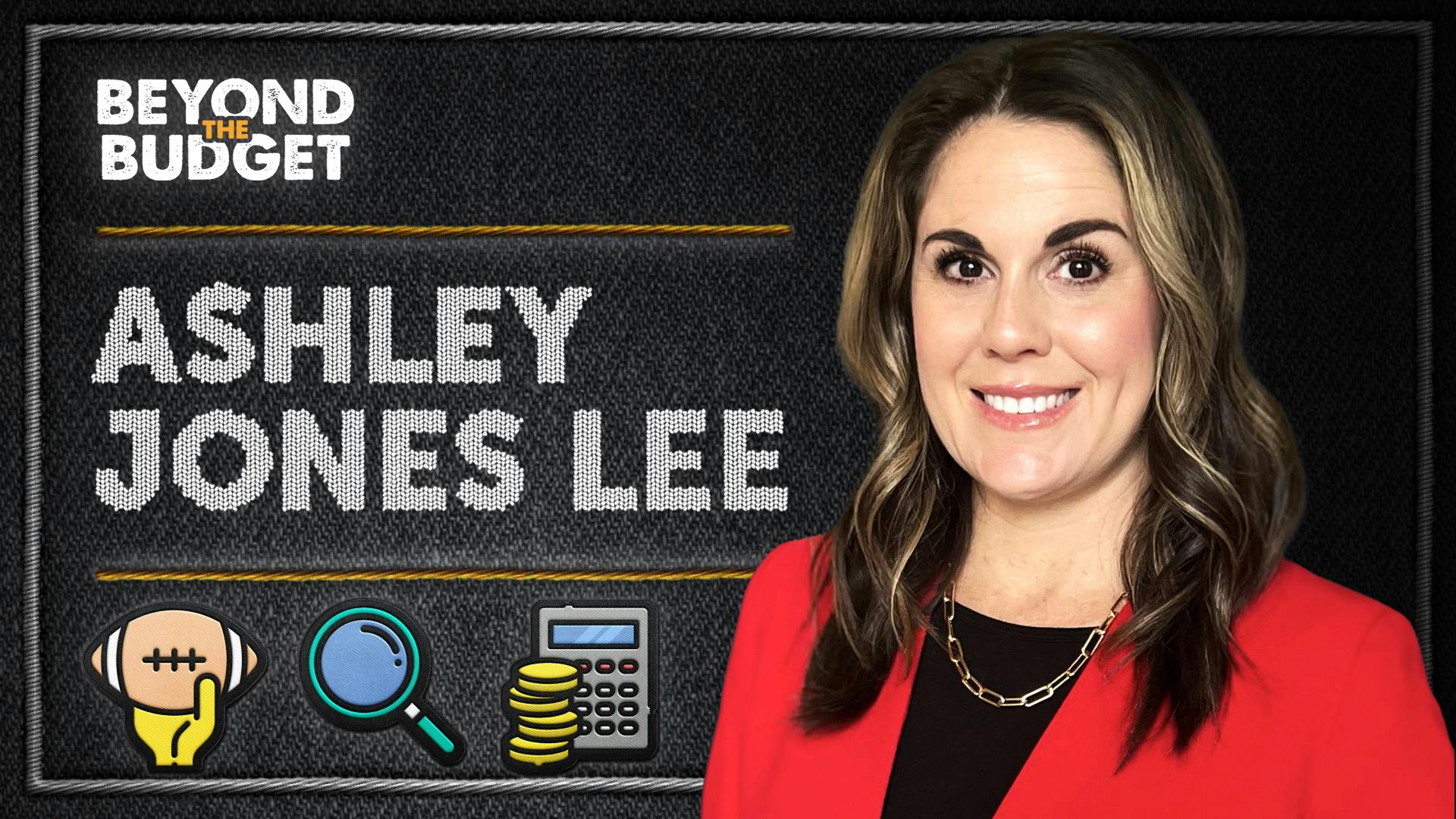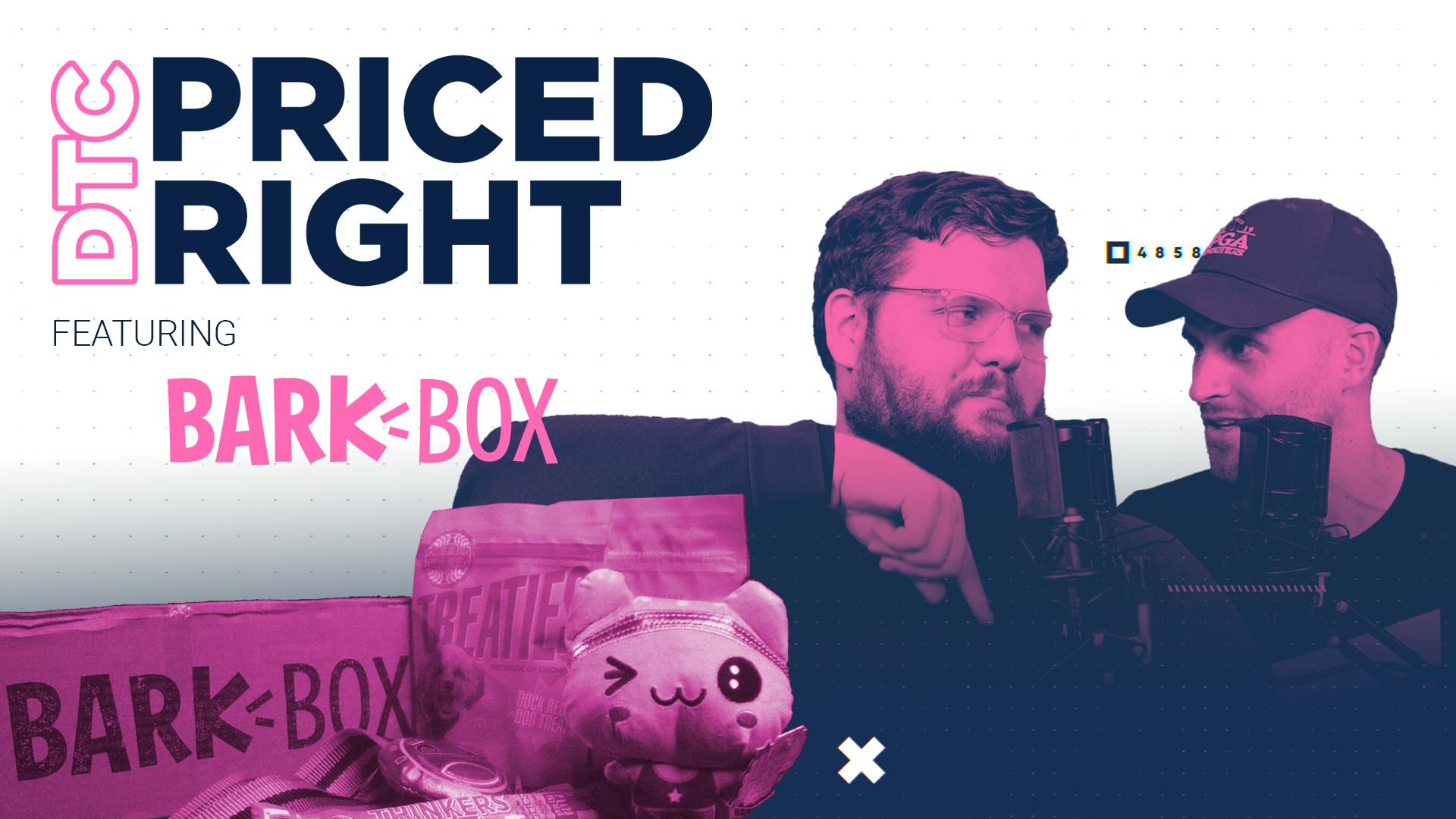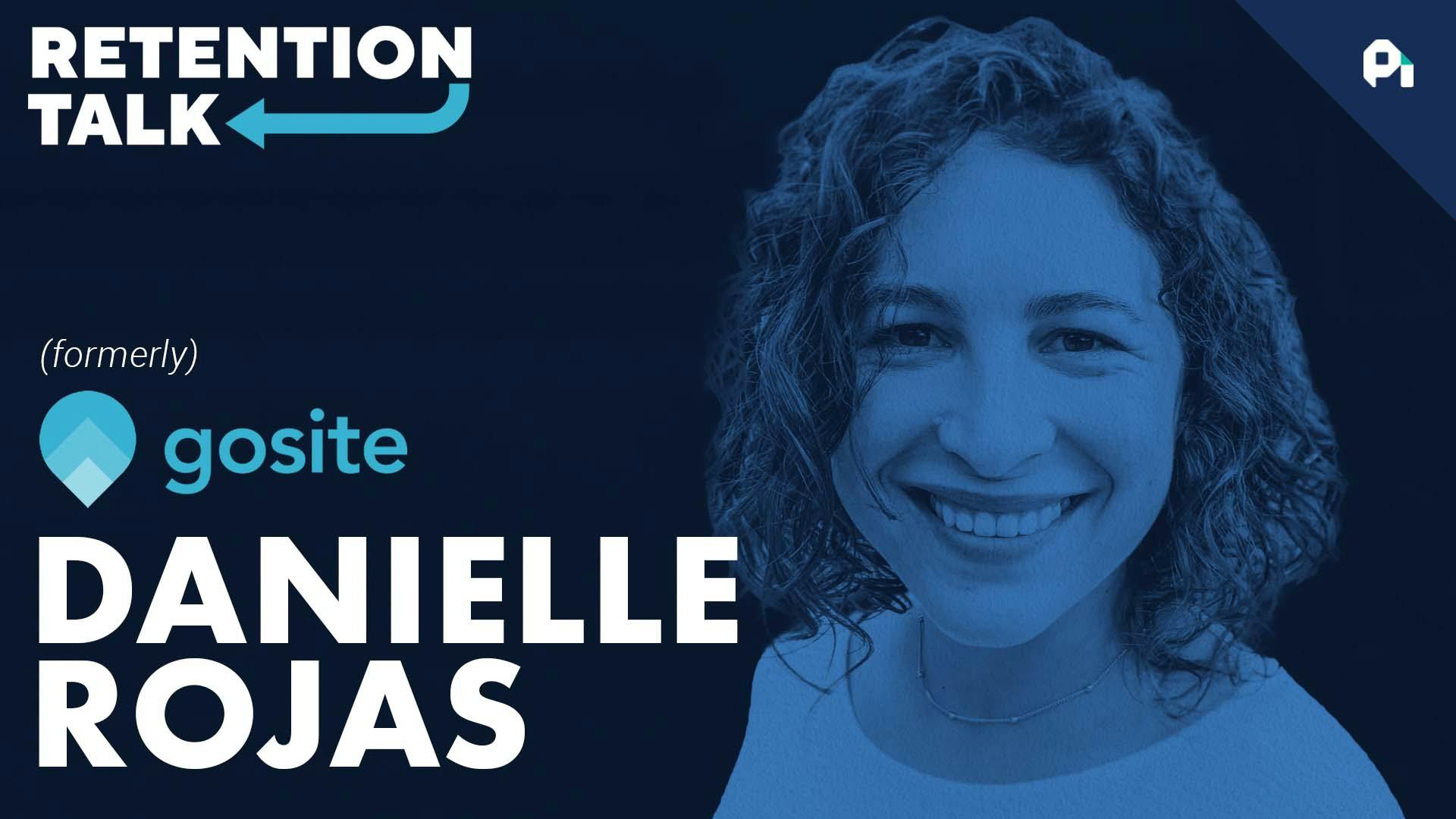
B-Side: Twitter Super Follow—the last shot in the war
This episode might reference ProfitWell and ProfitWell Recur, which following the acquisition by Paddle is now Paddle Studios. Some information may be out of date.
Please message us at studios@paddle.com if you have any questions or comments!
Pricing and packaging analysis of Twitter Super Follow
A couple of housekeeping notes and summary:
- Twelve of you sent me something along the lines of, "I love your content, but what in the world does ProfitWell do?" I'll do a post on this soon, but it's also a good indication that we have a lot of work to do on our product marketing. In short, we have a free subscription revenue metrics product that plugs into your billing system (Stripe, Zuora, Recurly, et al.) and gives you access to all of your financial metrics. Used by 24k+ subscription companies. We then make money through a product that reduces your subscription cancellations (Retain), optimizes your pricing (Price Intelligently), or does your Revenue Recognition (Recognized).
- Nine of you let me know that you love the content, but it's too long. My philosophy with this content is I want to give you diamonds. They're dense and sharp, but dagnabbit are they beautiful. I cut a lot of fat out of these and I don't mind making your brain hurt in a good way. If they're wordy—check out the audio version or follow me on twitter where I post a summary typically.
- Keep the feedback coming. I reply to every single one. : )
- The following post is on Twitter's decision to enter the subscription world. I've been talking about this for quite some time (as has Scott Galloway, and plenty of Twitter team members have been trolling those posts, so I hope I helped ;)), but to me this is the perfect move and it's not because of the obvious stock market reasons. Let's jump in.
Twitter failing upwards
Twitter's a frustrating company. Sure, the immature cattiness amplified by 280 characters is quite disheartening. Yet, the inability to truly push their revenue and stock forward for years pushes Twitter into the realm of having everything going for them and then some (Trump made them even more relevant), and then still whiffing to capitalize. It's infuriating.
Tides seem to be turning though. Particularly with the new subscription functionality they hinted at recently in an analyst presentation known as "Super Follow."
Creators will soon be able to charge their followers a subscription for exclusive content, discounts on merchandise, and a whole host of other goodies. They're essentially taking what Patreon, Substack, and OnlyFans have been doing for a couple of years now and merging them all into the Twitter platform.
Some are saying this is a Frankenstein attempt at reviving the brand and copying and pasting the subscription playbook that other tech companies have been doing to juice their market caps. While I'm sure an impetus, this shows an elementary level of understanding of what's happening in the market. For truth, we must go deeper. Plus, none of you are idiots, so let's not treat you like one.
We're going to explore why the move from Twitter's actually brilliant in the context of the shift in the attention economy, as well as do a data dive on if they made the right moves from a pricing and packaging perspective.
Let's ride.
From Platform Centricity to Creator Centricity
We first need to understand what's been happening in the attention economy (the term used to describe monetizing eyeballs). While the internet provided the ability for everyone and anyone to start and build an audience to eventually sell something to them, certain sites amplified eyeballs.
Before Twitter, et al., you needed to run ads, optimize for google search, and hopefully build word of mouth and an email list. The relationship was very transactional, which is why commerce and research took off. Us humans wanted to connect though, so social media sites came into play and started putting our offline networks online. Discovery started to happen and now we're at the point where most of my friends I've met online, and some I've never met in person.
We all struck an unspoken and potentially dangerous bargain with these social networks though. We'd give up privacy and create content for the platform to monetize through ads in exchange for amplification and reach.
For most folks—including your mom in Wisconsin—this didn't really matter, because she didn't really want reach and she actually appreciated those quilting ads. For others this was a beautiful opportunity to get their art, comedy, business advice, writing, or simply whatever, in front of an audience that they could build. This created quite the value loop.
Creators create content and Twitter amplifies that content while selling ads. The more ad revenue they ended up getting, the more you got promoted, thereby building more audience. You could then convince your audience to go off platform to buy merchandise, sign up for a newsletter, etc.
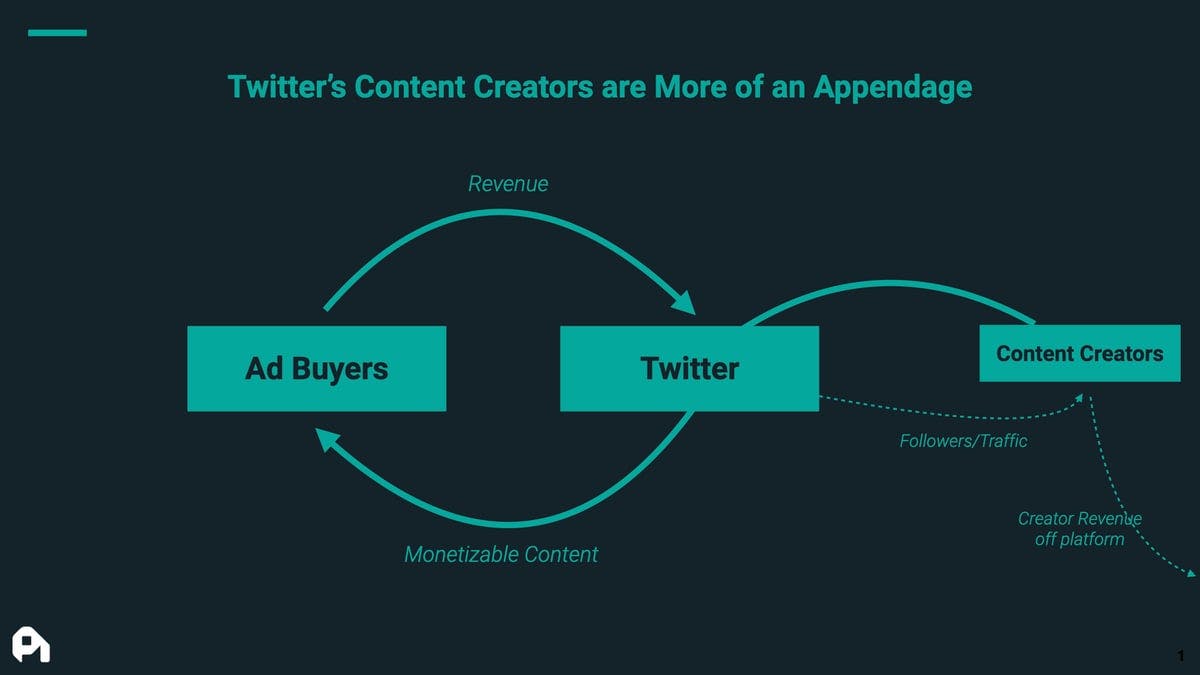
Everyone was pretty happy, until they weren't. There were a couple of big problems. You don't own your audience. Twitter does. Sure, some will go offsite and give you their email address, but Twitter has an incentive to not make that happen, so any links that lead off Twitter would get de-amplified. This created an impossibly difficult, high friction position to everyone.
Twitter trapped creators on Twitter and gave them no real way to monetize. Twitter still needed creators though, because they needed content to put ads on. Creators hated all this because their revenue creation kept going down and they couldn't communicate directly with their audience. Everyone's misaligned.
A lot of companies directly or indirectly started taking advantage of that misalignment.
- OnlyFans—a subscription service for adult entertainers—gave adult creators the ability to monetize their audience through a subscription. Most of these relationships started on Twitter. Why build an audience on twitter, when I can just do it on OnlyFans AND get paid?
- Patreon—a platform that allows creators to charge a subscription for their fans in exchange for exclusive content, merchandise discounts, etc.—gave creators the ability to monetize beyond ads and physical shows. Why even bother with Twitter when I can build my band's audience on Patreon and have a deeper connection?
- Substack—a platform for writers to charge their subscribers for access to their writing—gave writers the ability to circumvent the freelance world where media publications made money and make money directly. Why drive readers to my New York Times articles where they get all the money when I get 1000 true fans who pay my bills like that Ben Thompson guy?
What do these platforms have in common? What was the opening? Well, it comes back to the adage we've said many times: Whoever is closest to the customer AND makes it easiest for them to purchase, wins.
Substack, Patreon, and OnlyFans put the creator at the center of the universe and value chain. Creators just need to create and monetize. These companies then just take a cut.
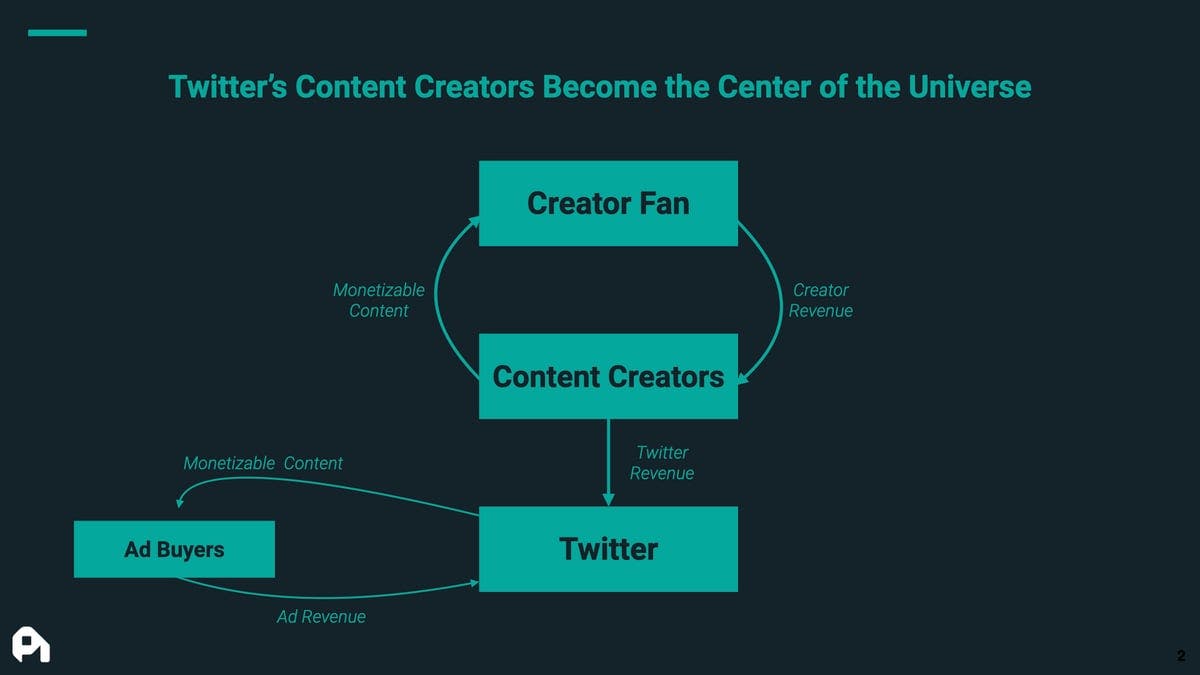
Twitter's joining the party late, but they have such an enormous advantage over these other companies: amplification. Patreon, Substack, and OnlyFans are not built from the ground up for discovery. Some like Patreon have actively said, "We're not here to get you the fans, only to help you monetize them." Others just don't have the technology for this. Twitter's been in the game of amplification for over a decade.
Twitter can now be the place for creators by ensuring that you don't have to leave where you already are to support those you find entertaining, knowledgeable, etc. I'm already on Twitter. I don't want to have to go to Patreon, Substack, etc. You may think this isn't a big deal, but remember we're all in a game to reduce friction as much as humanly possible. This is exactly what Twitter is doing with Super Follow. One-stop shop for creators and their audience.
Funny enough it also solves their ad problem. It's hard to explain to Pepsi that their ad showed up on a porn star's videos or that of a politically incorrect comedian making fun of a public figure. Moving to a subscription model makes them less reliant on ads, but could also put the onus of ad selection on that of the creator, causing an opt-in phenomenon.
Takeaways for your business
Map your value path and reduce friction
You need to map out who's getting value, how aligned you are to them, and where you're going to monetize. Most of you aren't social networks or even serving the creator economy, but you'd be surprised at the amount of value you can extract from a market by simply reducing friction. I find it easiest to actually physically map the market and the relationships between all the stakeholders. This doesn't have to be complicated, but it's exceptionally valuable.
Once you've mapped out the market, find a way to align the way you make money with your customer as much as humanly possible. Put your value metric, your customer, your packaging all on top of one another, rather than stretching them out amongst stakeholders.
Put the customer at the center of your decision-making filter
Substack is Mailchimp with a Stripe account. I know that's trivializing what they're doing, but can you imagine how Mailchimp, Constant Contact, Medium, et al., missed this? If they were putting the creator at the center of the value path and asking even the most basic questions, they may not have become Substack, but they probably could've pivoted as soon as they started seeing what was happening in the market.
You must, must, must put the customer at the center of your decision-making filter. You don't have to do what they say or deploy what they want, but you need to pick a side when it comes to building. My favorite anecdote recently on this was in a conversation Ev Williams (Twitter, Medium, etc.) and Paul Davison (Clubhouse co-founder) were having about Clubhouse. Paul views every decision through, "What is best for the creator?" Ads aren't best for the creator, so they aren't going to do them. Trolls aren't best for the creator, so they have anti-harassment precautions.
It's scary to pick a side or a central filament in a filter, but it's ultimately the right thing to do and ironically makes all decisions easier. At ProfitWell, our central filter is "what makes our users and customers more subscription revenue." That's our filter.
Ok. Super Follow is good, but did they package it properly?
Right now we don't know all the details about Super Follow, but the released screenshots show that a creator will be able to charge $4.99 per month so that super followers can get:
- Supporter Badge – to signal your patronage
- Subscriber only newsletters – likely similar to Substack
- Deals and discounts – rewards for being a super follower
- Exclusive content – video/audio only for their audience
- Community access – potentially similar to what Patreon does where Patrons can interact
It's a bit of a copy and paste job when looking at their, now, competitors, but let's actually collect some data on what this looks like from the market perspective. I put together a study on 4,791 current and prospective customers of Patreon, Substack, OnlyFans, and now Twitter Super Follow. The first analysis I ran is what's called a value matrix. Here we want to determine the relative value of the features included with Super Follow (X-axis) and cross reference it with willingness to pay (Y-Axis). Put another way, if we find a feature that the whole group likes, but the people who like the feature as their number one are willing to pay more, then that's a differentiable feature.
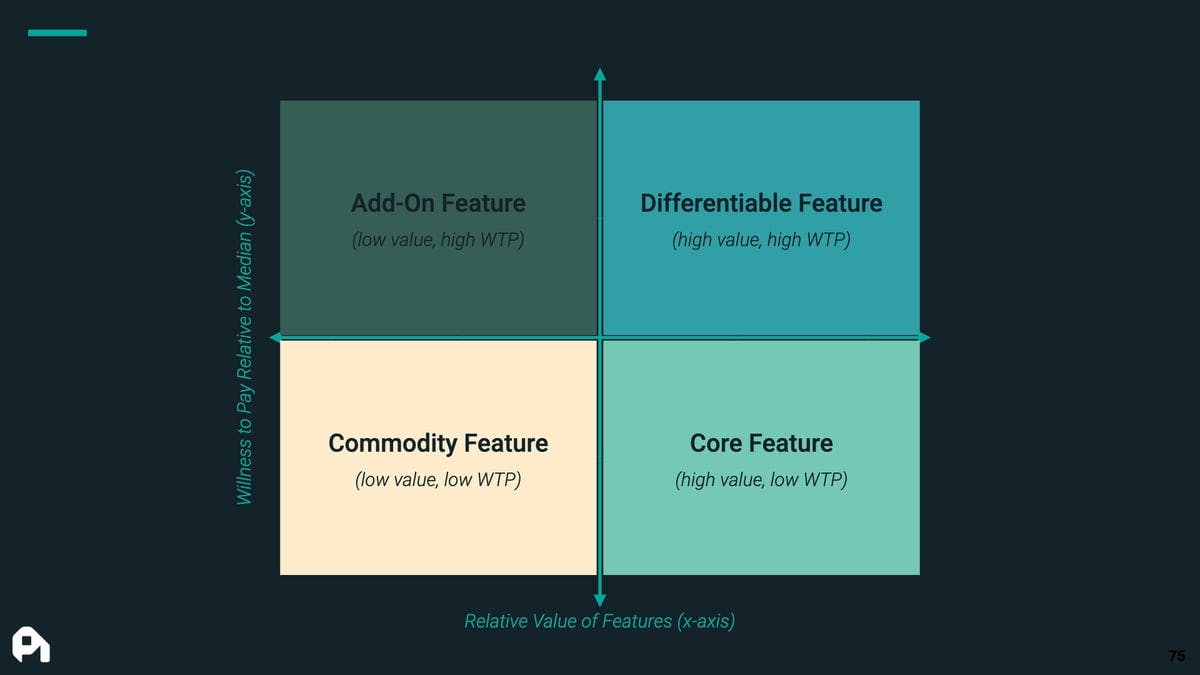
In analyzing the data, we measured the affinity of each respondent and put them into two buckets—super fans and passive fans—to see if there was a difference in willingness to pay and preference for features. Here are the results.
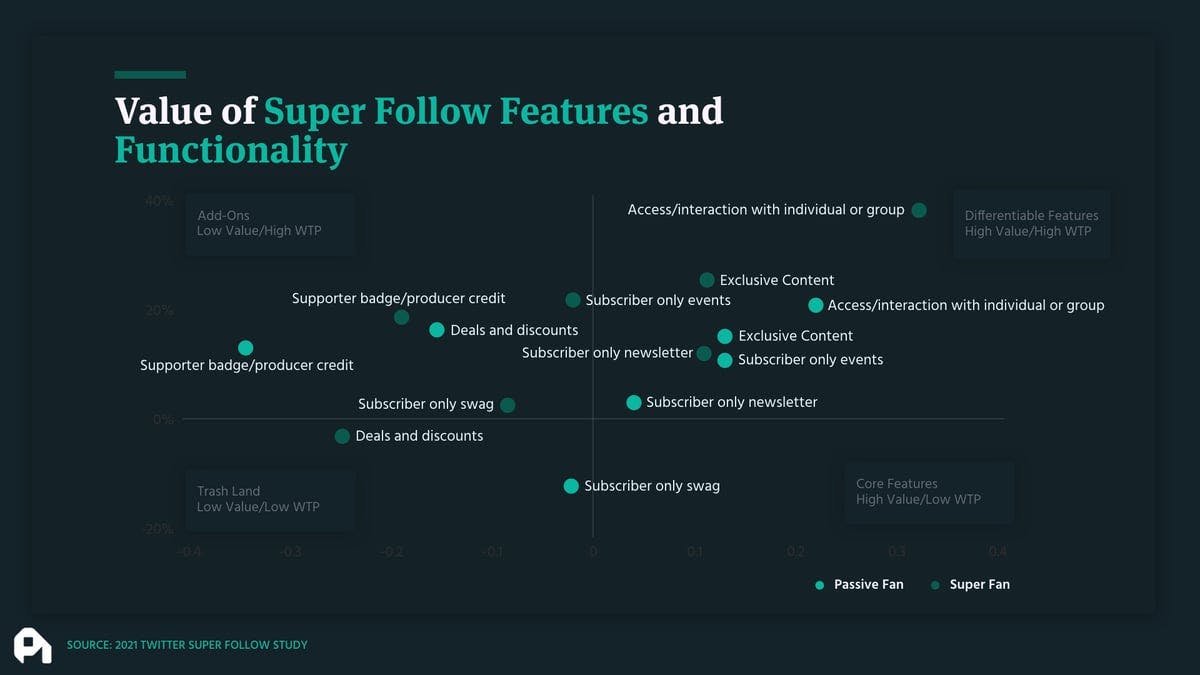
A couple of big takeaways:
- Notice how the super fans all had much higher willingness to pay than the passive fans (they're responses are higher on the vertical, y-axis). This stands to reason, because they're super fans. : )
- Supporter badges/producer credits don't seem to be a big driver of anything. Frankly, I bet that most folks don't want to necessarily show their support publicly for certain types of individuals (i.e. an adult entertainer). Others probably don't care much relative to the other features.
- Deals/discounts also get interesting, because you're already supporting the creator, so you're not thinking about deals when it comes to supporting them.
- Access seems to win out. This trends well with how people are thinking through having a relationship with someone that brings you joy or entertainment. It's not transactional.
Now let's look at willingness to pay on a number of axes. I hope Twitter puts this in the hands of creators to decide, because the $4.99 per month price point seems way too low across the board. First let's look at a cut of willingness to pay based on fan affinity.
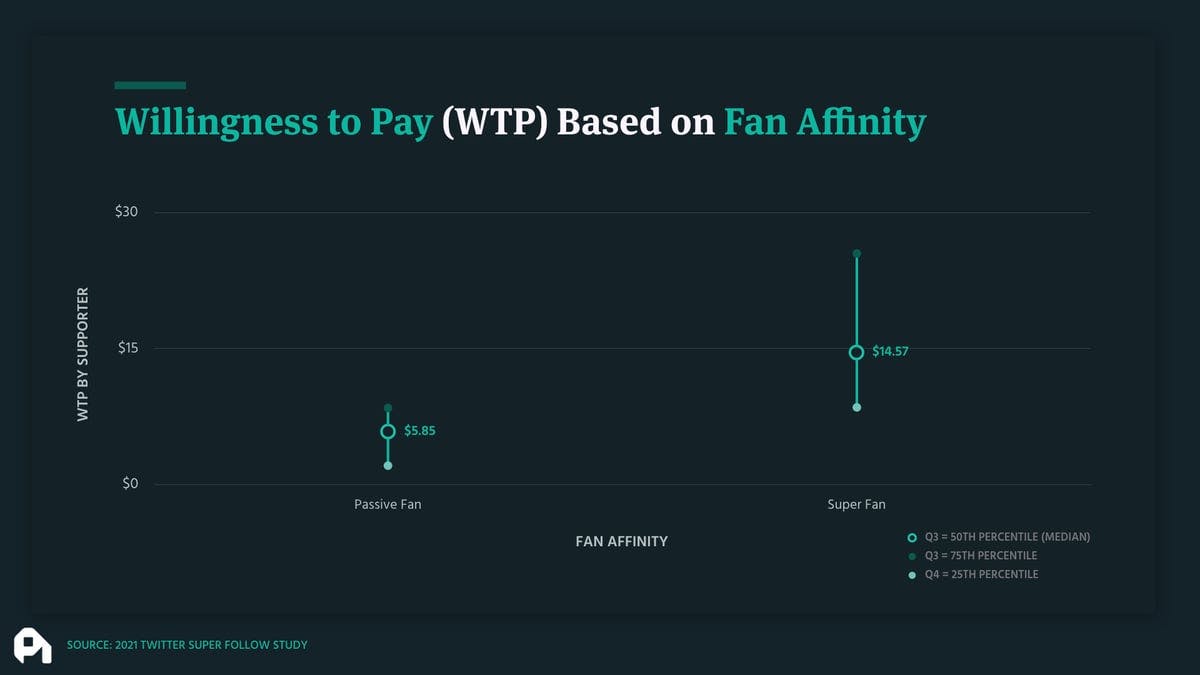
We expected super fans to have higher willingness to pay, but it's almost triple, which seems like a big jump. You're also seeing that overall willingness to pay is definitely trending above $4.99, even for the passive folks. Now let's look at willingness to pay based on the type of creator.
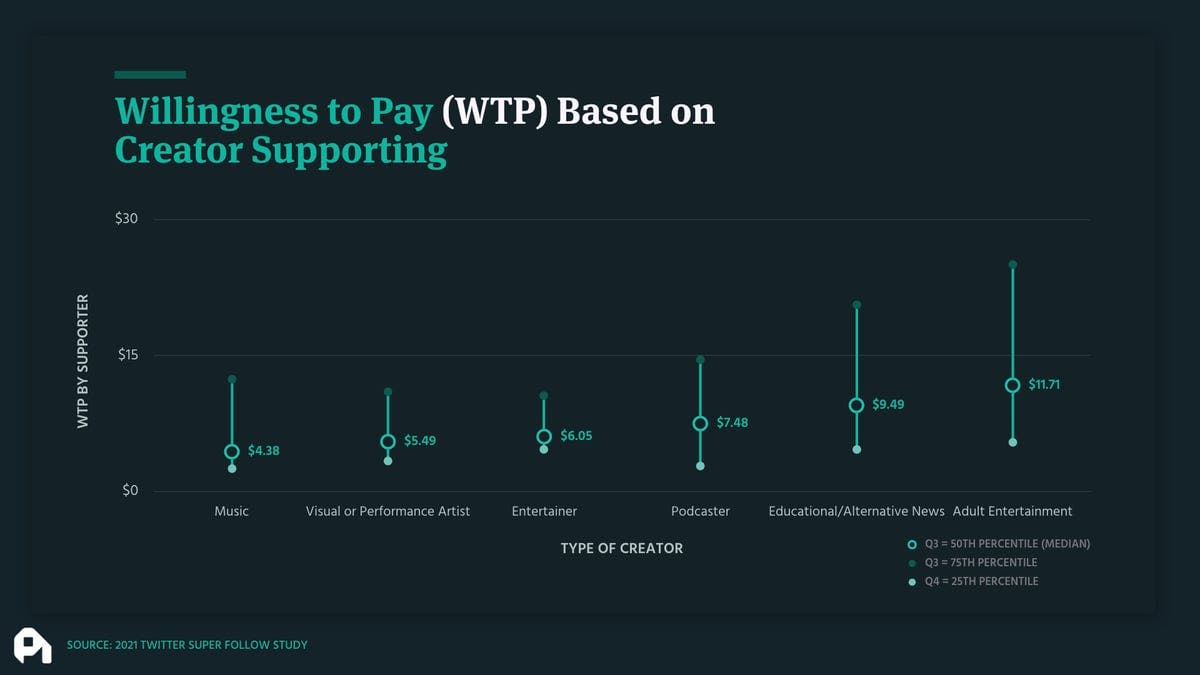
I need to process this a lot more, but this is a good indication of why adult entertainment is lucrative and why OnlyFans has taken off. Education and news being #2 gives me hope here, but also shows how fractured media is becoming. This is higher willingness to pay than the studies we've done for mass news subscriptions. Overall though, this is another indication that Twitter will make more money by letting creators set their own prices.
Cool. What do I take away for my business?
Shift your market into adult entertainment.
I'm kidding. Please don't reply to this email berating me. It's a joke and obviously that market has a lot of controversy—some deserved, some not.
Anyways, what should you do? I think this really comes down to the fundamentals of pricing and packaging strategy.
Understand your packaging and pricing
Notice how Twitter is pretty spot on with their packaging. They do a lot of research, which is great, but they also know they have a widely fragmented market. Deals and discounts will probably be mainly for brands, whereas the rest of the features will be for creators. Sometimes you need to make these decisions for different constituencies and while you never want to be everything for all people, you do need to balance your biggest customer verticals.
For your business, you need to do your research, because I guarantee you have plenty of features you think are great for driving value, but in reality they're not great at all. Similarly, I'm sure you're underpriced. I'm assuming Twitter is going to let creators set their own prices, but you have the power, obviously, to set your own. You likely have never done the research. Do it and make sure you're pushing towards your pricing power.
Community and Freemium are the future of connection
You probably thought I'd get to the end of something without pitching you freemium. You were wrong. : )
If we learn anything from this move, it's that connection is on the rise. We see brands castigated for political communication missteps. We see brands taking advantage of political and cultural trends. There's some cynical perspective there, but I also think there's a lot of power in getting directly with your customer before and after they've officially paid you. Freemium allows you to warm up those leads and make a connection in a way that a sales interaction can't. Community does the same.
If you're in B2B, it may be time to consider a community strategy. Same for DTC. We want to make connections with our brands and the things we buy. Make that easy on your customers.
Enough? Everyone get some value?
Ok. That's all for this week. If you enjoyed this post, I'd really appreciate if you shared it on the ol' Twitter or LinkedIn - or forward it to someone you think would get value.
Next week, I think we're going to go deep on some retention findings or value metrics, so until then—have a great end of the week.
Do us a favor?
Part of the way we measure success is by seeing if our content is shareable. If you got value from this episode and write up, we'd appreciate a share on Twitter or LinkedIn.
00;00;00;02 - 00;00;21;11
Patrick Campbell
I'm so aggravated by the shallow interpretation and analysis of this move that Twitter just made. None of you are idiots. Let's not treat each other like idiots and let's actually go deeper into why this will make assuming that they do this right, such a huge, huge impact on the market and ultimately the takeaways for your business.
00;00;22;26 - 00;00;41;16
Ben Hillman
From profit will recur. It's Protect the Hustle where we explore the truth behind the strategy and tactics of B2B SAS growth to make you an outstanding operator on today's episode, or diving deep on the pricing and packaging analysis of the Twitter super, follow Patrick. Take it away.
00;00;43;09 - 00;01;04;24
Patrick Campbell
Welcome back everybody, to another episode of Protect the Hustle. The voice you're hearing here is Patrick Campbell. This is my weekly newsletter where I work to learn in public or share things that I essentially am analyzing so that we can all become better. SAS and subscription operators. A couple of housekeeping items. So for one, make sure you're signed up and protect the hustle dot com.
00;01;04;24 - 00;01;20;11
Patrick Campbell
Basically go there. You can find lots of forms on that website just make sure you're signed up to not only get the emails which have all of the content right inside the email so you don't have to go anywhere, but also to make sure you get signed up for the podcast, which you're already listening to, but make sure you subscribe.
00;01;20;18 - 00;01;38;12
Patrick Campbell
We're just always going to have some things that are a little bit more visual. You can get 95% of everything by reading the email or by listening to the podcast. Just make sure when I get everyone gets the visuals, a couple of other things. So 12 of you sent me something along the lines of, Hey, I love your content, but what in the world is profitable do?
00;01;38;12 - 00;01;59;16
Patrick Campbell
Which I know is the funny thing, but I'll post more on this soon because I think it would be good to kind of go through that. But it's also a good indication that we have a lot of work to do on our product marketing. But in short, just to kind of answer that question, we have a free subscription financial metrics, product plugs into your billing system, stripes or curly whatever you're using and then gives you access to all of your financial metrics for free.
00;01;59;23 - 00;02;19;08
Patrick Campbell
And it's used by about 24,000 subscription and SAS companies, everyone from Johnny and Jane Startups to Fortune 50 companies. And then we make money through a couple of different products. One reduces your churn automatically and that is retained, one that optimizes your pricing and monetization strategy that's pricing intelligently and then one that does your revenue recognition, which is called recognized.
00;02;19;08 - 00;02;46;13
Patrick Campbell
And the basic idea is, is that we study data and then we deploy that understanding into products that help you make more money. Our North Star is anyone should be able to plug into profit well and basically make more subscription revenue immediately, either by analyzing what's going on with the free metrics or by using some of our paid products that should make you cash Another nine of you let me know that this content is great, but it's long and dense and my philosophy is tough.
00;02;46;13 - 00;03;08;08
Patrick Campbell
No, my philosophy is more, Hey, I'm here to give you diamonds. That's my goal. These are the things where I put the most effort into hopefully each week. And diamonds are dense and they're sharp, but dynamic. Are they beautiful? Right. So I do cut a lot of fat out of these. And so I hope you've noticed that no one said that I was rambling on anything, maybe on the podcast here and there, but my goal is to make your brain hurt in a good way.
00;03;08;08 - 00;03;26;04
Patrick Campbell
So if they're wordy, check out the audio version, which all of you are doing right now. Or you can just follow me on Twitter. How to Kiss the Childhood nickname right? Post a summary typically. And in that spirit, you know, keep the feedback coming. Like I reply to every single piece of feedback, either for more clarification or just, you know, kind of reaffirming what you said.
00;03;26;04 - 00;03;48;00
Patrick Campbell
And with that in mind, what we're going to talk about today, I should say, is on Twitter's decision to enter into the subscription world. They recently announced something called Super Follow. I'll get into that in a little bit, but I've been talking about Twitter getting into subscriptions for quite some time. I think I've been talking about longer than Scott Galloway, but Scott Galloway gets all the credit and of course Twitter team members have been trolling a lot of those posts.
00;03;48;00 - 00;04;03;05
Patrick Campbell
So I hope that I've influence them or I've helped them along the way in terms of this decision. That would give me a little bit of validation, even though I didn't get any money for those thoughts. But to me this is ultimately the perfect move and it's not because of this obvious, you know, Oh my God, it's going to help their market cap.
00;04;03;05 - 00;04;19;26
Patrick Campbell
I think that's the most elementary way that you could look at this. So with that kind of preface, let's jump in. So we all are probably familiar with Twitter. I know some of you aren't on Twitter because you've told me that when I've referenced you going to Twitter to talk to me. But Twitter just in of itself is a very frustrating company.
00;04;20;00 - 00;04;39;13
Patrick Campbell
It's got like this immature cattiness, you know, of people kind of sniping at each other in this is amplified by only 280 characters that you can kind of tweet with. And all of that is disheartening. But the real kind of frustration is the inability to truly push their revenue and stock forward for years. And they had everything going for them.
00;04;39;13 - 00;04;56;19
Patrick Campbell
They even in the last four years, had someone like Donald Trump make them even more relevant, because that's where kind of all the craziness was. And I'm not saying this was, you know, great for society or anything. This is not a political commentary on anything. It's just more of, hey, they had a lot of action going on and the stock basically stayed stagnant.
00;04;56;19 - 00;05;16;02
Patrick Campbell
The revenue basically stayed stagnant. It wasn't exactly stagnant. But, you know, there's just something where they're not by capitalizing and they're kind of whiffing on basically, you know, kind of pushing the product forward. And I think tides are showing that they're turning for a couple of reasons. But in particular, I think it really comes down to something that I already kind of mentioned, which is the super follow functionality.
00;05;16;15 - 00;05;37;15
Patrick Campbell
So to kind of explain what it is, basically people on Twitter. So if you have a Twitter account, you as a creator, whether it's, you know, tweeting about business advice or tweeting your art or putting up funny videos or whatever it is, you're soon going to be able to charge your followers a subscription for exclusive content discounts on merchandise, a whole host of other goodies.
00;05;37;15 - 00;06;04;16
Patrick Campbell
You get a little badge that you're a supporter of these types of things, and it's essentially kind of the Patreon playbook. If you know that company where, you know, bands and artists can basically charge their followers or their followers can support them by giving them an extra subscription, And this has been done by Substack in the writing community and also only fans in kind of the adult entertainment community where basically adult entertainers, porn stars can essentially put together their own content and then charge you a subscription for access to that content.
00;06;04;16 - 00;06;23;07
Patrick Campbell
And so these folks have been kind of doing this for a couple of years now. And then Twitter is basically coming in and merging these features onto the Twitter platform and what's kind of interesting is that some are saying this is just like a Frankenstein attempt at reviving the brand and kind of copying and pasting the subscription playbooks that a lot of other tech companies have been doing to kind of juice their market caps.
00;06;23;07 - 00;06;40;26
Patrick Campbell
So Apple, you know, a bunch of other kind of brands have basically done this recurring revenue bundle, which all of sudden gives them subscription revenue and then all of a sudden they're getting better market capitalization. But I'm sure that was kind of an impetus here. It just shows a really elementary level of understanding of what's actually happening in the market for Twitter.
00;06;40;26 - 00;06;57;02
Patrick Campbell
And so for truth, we obviously have to go deeper and none of you are idiots. So I don't want to treat you like one by using the most shallow analysis of what's going on. And so we're going to go deeper. And so we're going to explore why the move from Twitter is actually brilliant in the context of the shift in the attention economy.
00;06;57;06 - 00;07;12;21
Patrick Campbell
And the attention economy is basically the are these companies where their whole goal is to get you to use the product and that's where they make their money, whether it's Peloton, you know, getting the 30 to 60 minutes per day. So therefore you keep buying the subscription or it's Twitter or Facebook at all, like getting you to use the product and therefore like serving you ads.
00;07;12;25 - 00;07;33;18
Patrick Campbell
But we're going to go through this kind of brilliant shift I think is occurring and we're going to do a data dive essentially on are they making the right decisions for pricing and packaging. So that's what we're going to walk through. So first up, let's talk about this brilliant move in the context of the shift. So we first got to understand like what's happening in this whole attention economy, this is the term that's basically used to describe monetizing eyeballs.
00;07;33;18 - 00;08;02;03
Patrick Campbell
And if you think about the Internet, if we take like a huge step back, the Internet provided this ability for everyone and anyone to start and build an audience to eventually sell something to them in the certain sites out there that amplify these eyeballs, it gets you more eyeballs, right? And so before Twitter and Facebook and LinkedIn and all these other places, you had to run ads, you had to optimize for Google search and hopefully you built some word of mouth and captured some emails in order to get people to come to your site or for you to email them or text them or something like that in order for them to come check you
00;08;02;03 - 00;08;21;09
Patrick Campbell
out. And then typically by something. Now the relationship was very transactional, which is why commerce and research took off. You were making money by selling farm equipment online, you know, grass feed. I don't know why I'm thinking of agriculture so much right now, but you were making money basically by like taking offline things and selling them online, Right.
00;08;21;26 - 00;08;41;18
Patrick Campbell
And this is where, you know, basically either information or actual physical goods started to take off. And the kind of thing that shifted a little bit is that as humans, we wanted to connect with people. So social media sites kind of came into play and they started by taking our offline networks and putting them online. And then all of a sudden discovery started to happen.
00;08;41;18 - 00;09;08;21
Patrick Campbell
So we not only were just using, you know, kind of the rails of the Internet for ecommerce and for basically just kind of, you know, getting something that we wanted in a transaction. We started using it for our entertainment, we started using it for our connection, we started using it for fun and our procrastination. And as discovery started to happen, we're now at the point where a lot of our friends we've met online, some people that you've met online and our friends you've never actually met in person.
00;09;08;28 - 00;09;33;18
Patrick Campbell
You meet your spouses online or through some sort of app, and we're basically kind of using this offline, in this online in a really, really interesting relationship. Now, we're not going to go deep into kind of those personal connections, but when it comes to like social media networks, their whole goal was to then make these connections, give you discovery, entertain you, either through those connections or through, you know, content, and then basically, you know, sell apps in order to kind of justify it.
00;09;33;21 - 00;09;51;28
Patrick Campbell
And there was this unspoken kind of dangerous in some cases, bargain that we struck with these social networks as users, but also as creators and creators. I'm defining loosely as, you know, an obviously creator, like an artist or musician, but also people who are, you know, kind of business folks. You're a creator if you're designing a content playbook, you're a creator.
00;09;52;09 - 00;10;17;24
Patrick Campbell
But we gave up privacy and created content basically for free. They didn't pay us for their content, with some exceptions, and basically they were able to monetize that through ads and gave us some amplification. So for most of us, including like my mom in Wisconsin, like this didn't really matter because she didn't really want reach. It's not like she was trying to build her audience and she actually appreciated all those quilting ads that she got sent because it allowed her to discover more cool stuff.
00;10;18;03 - 00;10;35;14
Patrick Campbell
But this is very web 1.0 or 2.0, depending on how you want to look at it. Now, for others, this was also like a beautiful opportunity to get, you know, their arts, their comedy, their business advice, their writing or whatever they wanted in front of an audience that they can actually then build. And you just had this like really interesting value loop was happening.
00;10;35;14 - 00;10;59;07
Patrick Campbell
Creators created content and Twitter amplified that content while selling ads. And the more ad revenue they ended up getting, the more you got promoted, thereby building more audience. This is why when you look at even YouTube or even Twitter, the things that trend, the people that trend, they're obviously like very much in the same case, very much in the culture for good and mostly bad reasons or they're clean and friendly and they're able to kind of sell ads on top of them.
00;10;59;18 - 00;11;16;16
Patrick Campbell
And the more ad revenue they got, the more you got promoted and thereby that built your audience, more, you could then convince your audience. And this is where the end of the value loop came into play. You basically go off platform and buy merchandise for you or sign up for a newsletter and everyone was pretty happy until they weren't.
00;11;16;16 - 00;11;32;29
Patrick Campbell
And this was where a couple of the problems crept in because we went from Web 1.02.0 to Web 2.2 or 3.0, depending on how you want to measure it. You didn't own your audience. Twitter owned your audience. Some of them would go off site and give you their email address, but Twitter basically didn't have an incentive to make that happen.
00;11;32;29 - 00;11;51;22
Patrick Campbell
So what they started to do is they started to basically amplify anything that had a link or amplify anything that pushed people to a different platform. This is why on like LinkedIn, no one shares the links in the actual post because they amplify that particular content cause they want to keep people on LinkedIn. So this is why everyone puts that link in the comment.
00;11;51;22 - 00;12;15;17
Patrick Campbell
That's why you're seeing that also with Twitter, people stop putting links to content and they went to this kind of social first mindset because they're like, Yeah, I got to be on Twitter, but I kind of have to be there just to get some audience and maybe brand. So we moved from a transaction world with things like Twitter to a brand world, and this was really, really difficult because it created just this impossible high friction position for everyone.
00;12;16;02 - 00;12;36;02
Patrick Campbell
Twitter trapped creators on Twitter because it gave them no real way to monetize. So they kind of needed to be there, but they weren't really getting that much revenue from Twitter because Twitter started amplifying those types of links. And Twitter still needed those creators because they needed content to put ads on and creators hated all of this because the revenue creation kept going down.
00;12;36;02 - 00;12;52;15
Patrick Campbell
They couldn't communicate directly with their audience and everyone just became misaligned. And so what happened to the market and the reason that this happened in the market is, again, from that transaction world to kind of that connection world. And so a lot of companies started to prop up and basically directly or indirectly started taking advantage of that misalignment.
00;12;52;21 - 00;13;14;09
Patrick Campbell
We mentioned Onlyfans before. It's a subscription service for adult entertainers, basically adult creators. They can have the ability to monetize their audience through a subscription where basically you have to subscribe to them and then they give you access to their photos, their videos, or even a little bit of a community for my understanding. You know, why would I build on Twitter when I can just do it on my only fans and get paid?
00;13;14;22 - 00;13;30;19
Patrick Campbell
And a lot of those relationships started on Twitter. Twitter actually has a massive adult entertainment, you know, kind of client base. You don't really see it in your main feeds, but, you know, Twitter basically allows everything. You know, that was one of the advantages of Twitter had over like Facebook and some of the other kind of more cleaner networks.
00;13;30;29 - 00;13;49;14
Patrick Campbell
Patreon took advantage of this. You know, Patreon is a platform that allows creators to charge a subscription for their fans in exchange for exclusive content, merchandise discounts, etc., gave creators the ability to monetize beyond ads and physical shows or album sales. Like why even bother with Twitter when I can build my band's audience on Patreon and have a deeper connection?
00;13;49;14 - 00;14;11;27
Patrick Campbell
I can actually have conversations with them inside a community. And then the most recent example is Substack, a platform for writers to basically charge their subscribers for access to their writing. Basically, they can circumvent, you know, freelance work where the media publication makes all the money and make money directly. You know. Why drive readers to my New York Times article where they get all the money when I can get a thousand true fans who pay my bills, You know, like that Ben Thompson guy, right?
00;14;12;05 - 00;14;30;04
Patrick Campbell
So what do all these platforms have in common? Like what was the opening that they took? Well, it's a little obvious, but the state it is it comes back to the adage we've said many times already, which is whoever gets closest to the customer and makes it easy is for them to win or purchase. Excuse me, they ultimately win.
00;14;30;04 - 00;14;49;27
Patrick Campbell
Substack Patreon and Onlyfans put the creator at the center of the universe and the value chain creators just needed to create now and monetize. They didn't have to like get this, you know, really, really hard, you know, disconnection with ads and then hustle to get someone on a website. It was everything that was aligned. And then these companies would just take a cut.
00;14;50;14 - 00;15;13;00
Patrick Campbell
And if you're looking at the actual newsletter, there's actually an image here of basically the shift from how Twitter used to do this to what they're presumably doing now. A super follow and what these other companies did by attacking not only the way that everyone makes money, but also the most important velocity thing inside your business, in this case, content for someone like Twitter and the actual creator of that thing, in this case the actual creator.
00;15;13;17 - 00;15;34;15
Patrick Campbell
Now Twitter's joining late to the party, but I think that a lot of people are not seeing that they haven't enormous, enormous, enormous advantage over these other companies. And that's amplification. Patreon, Substack and Onlyfans, they are not built from the ground up for discovery. This is almost the entire point. Some, like Patreon have said, it is not our job to get you.
00;15;34;15 - 00;15;53;23
Patrick Campbell
Fans were only here to help you monetize them. Substack kind of the same thing. Discovery is not a central piece of this and they're associating discovery with ads, but that's not the thing that they're going after. And others just, you know, frankly, just don't have the technology for it. Twitter has been in this game for over a decade, the scheme of amplification.
00;15;54;09 - 00;16;20;28
Patrick Campbell
So where the advantage is is that not only Twitter is kind of censoring their value and mapping their value around the creator. So there isn't this disconnect between this ad revenue putting themselves in this position, but they have just everything aligned, but they also are setting themselves up to be the place for creators by ensuring that not only you don't need to leave to get the value from the creator, but you can also support those that you find entertaining, knowledgeable, etc..
00;16;21;11 - 00;16;39;26
Patrick Campbell
Put another way, I'm already on Twitter. I don't want to have to go to Patreon. I don't want to go to have to substack. I'm already opening Twitter too much during the day. Why don't I just add more? And you may not think this is a big deal, but remember, we're in this game to reduce friction as much as humanly possible and this is exactly what Twitter is doing with super follow.
00;16;40;05 - 00;17;07;18
Patrick Campbell
They're basically capitalizing on the monetization of these other platforms have made in giving you a one stop shop for creators in their audience. And really interestingly enough, this also solves their ad problem. So the ad problem that Twitter has been having is basically the idea that you can't put ads on questionable content or you can't, you know, put ads when, you know, things go viral and all of a sudden someone's ad ends up on, you know, something about, you know, some tragedy that occurs.
00;17;07;18 - 00;17;30;21
Patrick Campbell
And this is just one of the things that was a really, really bad externality to ads, in addition to, you know, ads basically incentivizing cattiness and aggressiveness, because those are the things that essentially spread. And Twitter wanted content that would spread. So they were in this hard position. And it's hard to explain to Pepsi why their ad shows up on, you know, a porn star's video or the video of a politically incorrect comedian making fun of some public figure.
00;17;31;04 - 00;17;48;09
Patrick Campbell
So when Twitter moves to a subscription model, it makes them less reliant on ads, but could also put the onus of the ad selection of that on the creator, causing just kind of this opt in phenomenon. And so Twitter will be able to push maybe they're more questionable people to this type of monetization model and they're less questionable.
00;17;48;09 - 00;18;03;24
Patrick Campbell
People can basically be pushed into still this model, but also on ads. And so they're kind of getting this one two punch where they can have their cake and eat it, too, because there's some signaling that's actually happening with the ad model. So a couple of big takeaways for your business. You got to map your value and reduce friction.
00;18;03;24 - 00;18;20;25
Patrick Campbell
And I know this seems so obvious, but not enough of us are physically getting out a piece of paper and just drawing out your ecosystem. You've got to map out who's getting value, how aligned you are to them, and we're going to monetize. Most of you are not Twitter or social network, you're not even consumer brands, most of your B2B brands.
00;18;20;25 - 00;18;44;17
Patrick Campbell
And that's great, but you have to make sure that you actually map things out because you'd be surprised at the amount of value you can extract from a market by simply reducing friction and recognizing where that friction is. And I find it easy, as I've already alluded to, it actually physically map this out. There's a couple of examples in the actual posts in the email of looking at Twitter and kind of the before and after of how they've mapped it doesn't have to be complicated, but it's an exceptionally valuable exercise.
00;18;44;17 - 00;19;11;24
Patrick Campbell
And once you've mapped things out, you basically just find a way to make sure that you align the way you make money with your customer as much as humanly possible. This might mean a value metrics or retain product that you know, we recover and reduce churn for you. Basically, you know, we charge based on how much we recover and not all of you will be able to do that, but you'll be able to find a proxy metric that you can essentially charge on and then make sure that you're actually aligning as much as humanly possible rather than kind of stretching things out among stakeholders and putting you in the middle.
00;19;11;24 - 00;19;32;11
Patrick Campbell
That's probably a better way to say this is like, stop putting yourself in the middle, start putting your customer actually in the middle, which value mapping actually will help you show. Now, this brings me the second point is you got to put the customer at the center of your decision making, particularly with the filter. What's really kind of fascinating, what kind of troubles me is just how much of a missed opportunity, you know, some of these other companies had.
00;19;32;11 - 00;19;59;20
Patrick Campbell
So substack the newsletter product, it is MailChimp with a Stripe account, it's a medium with a Stripe account, and I know that's trivializing it. But like, can you imagine how MailChimp constant contact and medium actually miss this? If they were putting the creator, the person actually putting the content through MailChimp, through content, contact, through media, and not all of them were necessarily focused on like creators and people putting things together, but medium certainly was.
00;20;00;01 - 00;20;32;08
Patrick Campbell
If they actually put those individuals at the center of their value path and even asked the most basic product questions, they may have actually become substack. And even if they didn't, they could have pivoted. Really quickly when they started seeing the shift that happened in the market. And you got a guy who got to put the customer at the center of your decision making filter because you don't have to do what they say or deploy what they want, but you need to pick a side when it comes to building and too many products out there, you try to be everything to all people and that's really, really hard.
00;20;32;08 - 00;20;51;17
Patrick Campbell
But if you pick a side or you pick something that you're optimizing for, it allows you to filter decisions. And ironically, it becomes a lot quicker to make these decisions. So recent anecdote that happened, basically one of the founders of Twitter of Williams and the founder of Clubhouse, I was in a room where they were kind of talking to one another on clubhouse, which is this live audio app.
00;20;51;17 - 00;21;17;09
Patrick Campbell
And basically, Paul, the co-founder of Clubhouse, was saying every decision is filtered through what is best for the creator. Ads aren't best for the creator because of all the things we talked about. So they aren't going to do them. Trolls aren't best for the creator, so they have anti-harassment precautions and a troll button where the creator can basically say, Oh, this person was trolling in a particular room and they don't care about the consequences of that because everything is filtered through the Creator.
00;21;17;09 - 00;21;39;01
Patrick Campbell
And if you look at Twitter, Twitter didn't filter everything through the creator. They filtered everything depending on the decision through different aims. Oh, we're going to prioritize this because of the advertisers. So we're going to prioritize this because the people on the platform, they went back and forth and if they just chose a side that's central piece of their value map, they would have been able to basically avoid missing out the past five or six years.
00;21;39;13 - 00;21;57;27
Patrick Campbell
And it's scary. Don't worry. It's totally scary, but it's ultimately the right thing to do. And ironically, it makes those decisions easier. You know, profit. Well, I already mentioned this, but we filter everything through, makes our users and customers more subscription revenue. If it doesn't do that, why are we doing it? All right. What's transition here to super follows?
00;21;57;27 - 00;22;14;10
Patrick Campbell
Good. Let's actually analyze it from a pricing and packaging perspective. We're going to use profiles price intelligently software to basically check this out and I'll talk through the graphs for those of you who are on or just listening to the audio. But check out the email because it has all of the actual graphs in it. So first up, what did super follow include?
00;22;14;10 - 00;22;31;28
Patrick Campbell
Well, basically we don't know a lot. And so that's where this becomes a little bit tough. But they basically showed us a screenshot where, you know, someone could super follow someone for 499 per month. So five bucks per month. And that included a supporter badge to signal that, you know, you're a supporter of this particular person or group subscriber only newsletters.
00;22;32;02 - 00;22;51;15
Patrick Campbell
This is probably similar to substack deals and discounts, you know rewards for being a super follower, exclusive content. You know, this is probably only for that audience and then community access potentially similar to what Patreon has, where the patrons can actually interact not only with themselves but also with the Creator in some way. So this is a bit of a copy paste job from these competitors.
00;22;51;15 - 00;23;16;07
Patrick Campbell
Don't get me wrong, this is exactly what patrons are doing Substack, Onlyfans, etc. But let's actually validate it. And we've done this before in our show pricing page, Tear down for Patreon and some other folks, including Twitter. But let's actually collect some data on what this looks like from a market perspective. So I put together a research study on 4791 current and prospective customers of Patreon Substack only fans may now Twitter super followers.
00;23;16;07 - 00;23;37;20
Patrick Campbell
So these are people who basically answered a couple of questions where they are, you know, potentially going to use these types of products or they already are using these types of products. And the first analysis I did called a value matrix. So it's kind of a classic to buy too. And what you do is basically want to determine the relative value of features included with super follow in this case, and those go along the x axis.
00;23;38;02 - 00;24;03;12
Patrick Campbell
So the horizontal access, and then we cross-reference it with willingness to pay. So that's the y axis of the vertical access. So put another way, if we find a feature that the whole group likes, like it's one of the most important features, but then also the people who really, really like that feature is their number one. They're willing to pay more than that feature ends up in the upper right quadrant, so high x access and high Y access.
00;24;03;22 - 00;24;26;19
Patrick Campbell
I mean, if you're looking at the visual here, there's four boxes. So up in the upper right, those are differentiable features. The upper left, those are add ons, lower right, those are core features excuse me. And then lower left are more commodity type features. And so in analyzing the data was really kind of interesting is we also cross-referenced the data by asking a couple of questions about how big of a fan are they typically of these types of things?
00;24;26;19 - 00;24;50;18
Patrick Campbell
Are they a super fan or are they just a passive fan? So we separated out into those two particular groups and the results we found, and I'm not going be able to describe all of this on the actual podcast here, but the results we found are super interesting. Basically what you're looking at is the most important or the biggest driving features were things like access or interaction with the individual or group, which intuitively make sense, right?
00;24;50;27 - 00;25;11;08
Patrick Campbell
The whole point is to make a connection with these people or this group that you're going after. Right Next up were things and this is kind of all converging like exclusive content subscriber only newsletter you know, tested pretty well. And then there's a lot of other things that didn't necessarily test that well in terms of how important they were deals and discounts.
00;25;11;08 - 00;25;33;18
Patrick Campbell
Not really. Anyone really cared about those from a feature perspective. Same thing with supporter batch subscriber only kind of events didn't show up that well, nor did like subscriber only swag. Now, all of these did have higher willingness to pay, meaning that the people who cared about them did have higher willingness to pay. But overall, the story that I'm seeing is, is that really just access?
00;25;33;18 - 00;25;54;11
Patrick Campbell
That community is so, so important in the exclusive content and it was kind of funny because when we look at some of these takeaways, the super fans just overall had much higher willingness to pay than the passive fans. And we'll talk about this more specifically in a second. Supporter badges producer credits were not a big driver of anything, neither value of the feature or willingness to pay.
00;25;54;11 - 00;26;11;05
Patrick Campbell
And I bet it's because most people they might not want to show their support publicly, particularly for like adult entertainers and then other people, they don't really care, right? It's not like, hey, I'm part of the Justin Bieber fan club. It doesn't give me any street cred. Oh, I had a Zoom with Justin Bieber. That gives me a lot more street cred, deals and discounts.
00;26;11;05 - 00;26;26;09
Patrick Campbell
I bet you those people who have higher, you know, kind of affinity here, they don't really care about the deal or the discount. This might be a little bit different for brands because maybe I want to be a part of the exclusive alley pop, you know, subscription. And I want deals and discounts for being a part of that VIP program.
00;26;26;09 - 00;26;48;16
Patrick Campbell
But really it all comes down to access. Now, as I mentioned, we are also looked at willingness to pay in a number of axes. And I really hope that Twitter puts this in the hands of creators, meaning creators can make the decision of how they want to set their price because for 99 is basically not right. And so we've seen this with like Patreon is that most creators like underprice their products.
00;26;48;17 - 00;27;10;08
Patrick Campbell
Now when we looked at Affinity so passive fans kind of their median willingness to pay was just under $6 a month. So a bit higher obviously than the $5 a month in the range went up to just over $8 and down to just over $2. But the superfans there were willing to pay about $15 per month for access basically to the artist or the band or whoever that they want access to.
00;27;10;08 - 00;27;27;20
Patrick Campbell
So that was pretty interesting to see. Now, where this got really interesting as we broke down the willingness to pay data based on the type of artist or the type of creator, everything from adult entertainers down to like music. And what we found is, is that it's really kind of interesting. So willingness to pay increased in this order.
00;27;27;24 - 00;27;48;27
Patrick Campbell
So musicians had the lowest willingness to pay right around about $5 per month, meaning, you know, you subscribing to a musician or a group visual or performance artists was a little bit higher, just over $5. Entertainers were just at about $6, podcasters about 750 per month. And these are all the mediums. Educational or alternative news was about $10 per month.
00;27;49;05 - 00;28;04;21
Patrick Campbell
And then adult entertainment one out and about $12 per month. And they had the highest range up to about $25 per month. So I don't know what that says about our priorities as humans, but it definitely shows like the highest willingness to pay. And it's also a good, you know, a clear reason why, like Onlyfans has taken off.
00;28;05;02 - 00;28;29;22
Patrick Campbell
But I guess like the fact that education and news being number two gives me a little bit of hope for humanity. But, you know, it also shows that there's a really fractured, you know, industry in multiple different ways, not only for, you know, what's happening in adult entertainment, but education in news, but also for all of these different types of creative worlds where all these middle, you know, steps have been cut out and now you can basically go exactly to your fans, which I think is a beautiful, beautiful thing.
00;28;30;05 - 00;28;47;16
Patrick Campbell
I think this also shows that Twitter will make more money if they let the creators set their price, because some people are going to set higher prices, which I think is great. So cool. Let's wrap this up. What should you do for your business? Obviously, you're not Twitter, but basically what we're seeing from the data is that you should shift everything you're doing to the adult entertainment.
00;28;47;16 - 00;29;04;25
Patrick Campbell
And I'm just kidding. That's not what I'm saying. Please don't reply to this email like berating me. You know, it's a joke. Obviously, that market has a lot of controversies, some deserved, some not. But what should you do? I think this really comes down to the fundamentals of pricing and packaging. So for one, Twitter is basically spot on with their packaging.
00;29;04;25 - 00;29;31;09
Patrick Campbell
I know that they do a lot of research internally. We've talked to their research team before and that's great. But they also know that they have a really widely fragmented market. So, you know, things like deals and discounts will probably be mainly for brands and actually ecommerce businesses. The rest of the features probably for creators. And sometimes you got to make these decisions for the different constituencies that you have and you're never going to be everything to all people, but you do need to balance your biggest customer verticals and for your business, you've got to do your research.
00;29;31;09 - 00;29;48;07
Patrick Campbell
I guarantee that you have plenty of features you think are driving value, but in reality they're not great at all. And similarly, I'm sure you're underpriced. I am assuming, you know, Twitter is going to let these creators set their own prices, but you have the power, obviously, to set your own price and you likely have not done this research.
00;29;48;07 - 00;30;12;06
Patrick Campbell
80 to 90% of the companies I interact with her under price in some particular way. Please make sure you are actually pushing towards that pricing power. And then the final thing here that I think is a little bit more long term because I think you're pricing in packaging is a little bit easier to fix Short term community and freemium, though, the future of connection, you probably thought that I was going to get to the end of this post without mentioning freemium, but you were wrong, basically.
00;30;12;19 - 00;30;42;10
Patrick Campbell
And I think that if there's anything that we're learning from this move, it's that connection is on the rise. We see brands that are castigated for political communication missteps. We see brands taking advantage of cultural trends. I think that we are heading into this world where you as a buyer, you care about who your brand is, and that can be kind of a tricky situation because, you know, your brand is made up of a lot of team members that probably have many different political affiliations and cultural norms and trends and these types of things.
00;30;42;24 - 00;30;59;11
Patrick Campbell
But it does signal that people want a connection with the things that they buy. And this is a very, very big trait amongst millennials as well as Gen Z, which are becoming, you know, the largest purchasers, you know, basically in the market. And so I think you don't want to take advantage of this by kind of being fake.
00;30;59;11 - 00;31;18;02
Patrick Campbell
And we have seen some brands do this, but there's a lot of power in getting directly with your customers before and after they've officially paid you. And freemium allows you to warm up Those leads, help them make a connection, and community can do the same. If you're in B2B, it's probably time to consider a community strategy, and that's just not social.
00;31;18;02 - 00;31;36;06
Patrick Campbell
That's actually like starting a community either through Slack or Patriot and even or a couple of other places. You know, same for DDC. We want to make connections with our brands and the things that we buy, and you got to make that easy on your customers. So enough everyone get some value. Hopefully that's the case. That's all for this week.
00;31;36;06 - 00;31;52;01
Patrick Campbell
If you enjoyed this post, this episode, please, please, please really appreciate if you shared on Twitter, LinkedIn, wherever you are, or if you just forward it to someone who you think will get some value. We're measuring success basically on spread here as well as replies, so feel free to hit me up if this was or wasn't valuable for you.
00;31;52;11 - 00;32;08;16
Patrick Campbell
And next week I think we're going to go deep either on retention or on value metrics. I haven't written the post yet, so let me know if you want one of those or want me to go deep on something else. But of course everyone have a great end of the week. Have a great weekend and we'll talk next week.
00;32;10;27 - 00;32;51;12
Ben Hillman
Thanks for listening. If you enjoyed this episode, we really appreciate it. If you left a five star review of this podcast or the equivalent rating wherever you listen or watch. Also, make sure you subscribe to and tell your friends about Protect the Hustle, a podcast from Al Roker, the largest, fastest growing media network dedicated to the world of subscriptions.

